Overview
- Features: Buddhist monastic caves with renowned frescoes
- Opening Times: 9am to 5:30pm, daily except Monday
- Best Time to Visit: Late October to early March
- Duration: Full Day
- Travelled By: Bus,
- Cost: Indian/foreigner Rs 10/250
- Address: Ajanta, Maharashtra, India
- Type: Historic site
Author Reviews[display_rating_item_results rating_form_id=”2″ rating_entry_ids=”1″ show_category_filter=”false” show_options=”true” result_type=”star_rating” preserve_max_rating=”true” show_title=”false” show_count=”false” ]
Total Rating: [display_rating_result rating_form_id=”2″ show_count=”false” show_rich_snippets=true] [accordions load=”1″] [accordion title=”User Reviews” last] [display_rating_item_results rating_form_id=”5″ show_options=”true” result_type=”star_rating” preserve_max_rating=”true” show_title=”false” show_count=”true” show_rich_snippets=true] [/accordion] [accordion title=”Add Review”][display_rating_form show_email_input=”true” show_comment_textarea=”true” show_name_input=”true” rating_form_id=”5″] [/accordion] [/accordions]
Summary
Did you know that there are about 30 caves at Ajanta Caves? You might want to see them all or you would rather just visit the best ones. Below we have handpicked the best and most popular caves at Ajanta because they are unique and have the best preserved art and architecture. Plus, there’s loads of other interesting information on the Ajanta Caves, tips for visiting and much, much more.
Best Ajanta Caves to Visit
Interesting Facts About Ajanta Caves
- Known as the Louvre of ancient India, the Ajanta Caves are described as “the finest surviving examples of Indian art”
- The caves are located 105km northeast of Aurangabad in the Indian state of Maharashtra
- Since 1983, the Ajanta Caves have been a UNESCO World Heritage Site
- The Ajanta Caves are made up of about 30 rock-cut Buddhist caves
- The caves date back from the 2nd century BC to the 6th century AD
- Ajanta Caves are masterpieces of Buddhist religious art, with figures of the Buddha and depictions of the Jataka tales
- These caves were among the earliest monastic institutions to be constructed in India
Ajanta Caves History
Ironically, it was Ellora’s rise that brought about Ajanta’s downfall, and historians believe the site was abandoned once the focus had shifted to the newly-built caves of Ellora. Upon being deserted, the caves were soon reclaimed by wilderness and remained forgotten until 1819, when a British hunting party led by officer John Smith stumbled upon them purely by chance.
In 1819, a party of British army officers from Madras noticed the top of the façade of Cave 10 while tiger hunting. They investigated and discovered some caves, describing seeing ‘figures with curled wigs’. Others made exploratory trips to the fascinating caves. In 1843, James Fergusson, horrified by the ravages of the elements, requested that the East India Company do something to preserve and protect the deteriorating caves.
In 1844 Captain Robert Gill, an artist, was sent to copy the paintings on the cave walls. He spent 27 years living in a small encampment outside, sending each new batch of paintings to Bombay and London. After nearly 20 years his work was almost complete and displayed in the Crystal Palace in London. In December 1866 all but a few of the paintings were destroyed in a fire. Gill soldiered on for another five years before giving up, and died from illness soon afterwards. He is buried in the small European cemetery at Bhusawal, 60 km to the north, 27 km from Jalgaon.
The Ajanta Caves Site
[singlepic id=2045 w=720 h=560 float=center]
The caves are cut from the volcanic lavas of the Deccan Trap in a steep crescent-shaped hillside in a forested ravine of the Sahyadri Hills. The terrain in which they were excavated was a sheer cliff facing a deeply incised river meander. At the height of Ajanta’s importance the caves are thought to have housed about 200 monks and numerous craftsmen and labourers. The masterpieces retell the life story of the Buddha and reveal the life and culture of the people of the times, royal court settings, family life, street scenes and superb studies of animals and birds. The Jatakas relate the Buddha’s previous births – showing the progress of the soul.
Originally the entrance to the caves was along the river bed and most had a flight of stairs leading up to them. The first to be excavated was Cave 10, followed by the first Hinayana caves (in which the Buddha is not depicted in human form), on either side. Later Mahayana caves were discovered, completing the spectrum of Buddhist development in India.
The primary reason to visit Ajanta is to admire its renowned ‘frescoes’, actually temperas, which adorn many of the caves’ interiors. With few other examples from ancient times matching their artistic excellence and fine execution, these paintings are of unfathomable heritage value. It’s believed that the natural pigments for these paintings were mixed with animal glue and vegetable gum to bind them to the dry surface. Many caves have small, crater-like holes in their floors, which acted as palettes during paint jobs.
Despite their age, the paintings in most caves remain finely preserved today, and many attribute it to their relative isolation from humanity for centuries. However, it would be a tad optimistic to say that decay hasn’t set in.
Dos & Don’ts at Ajanta Caves
Signposts placed at the entrance of the complex list a series of ‘Dos and Don’ts’ intended to reduce human impact on this vulnerable site. Please comply.
Flash photography is strictly prohibited within the caves, due to its adverse effect on natural dyes used in the paintings. Authorities have installed rows of tiny pigment-friendly lights which cast a faint glow within the caves, but additional lighting is required for glimpsing minute details, and you’ll have to rely on long exposures for photographs.
Most caves in Ajanta have to be entered barefoot (socks allowed) so wear shoes that can be removed easily.
Viewers are allotted 15 minutes within Caves 1 and 2 and are not allowed to linger any longer.
Amenities at Ajanta Caves
[singlepic id=1909 w=720 h=560 float=center]
A cloakroom adjoining the toilets near the main ticket office is a safe place to leave bags (Rs 5 per item for four hours).
The caves are a short, steep climb from the ticket office; the elderly can opt for a chair carried by four bearers (Rs 400).
Tips for Visiting Ajanta Caves
Authorised guides are available at the entrance to show you around for a fee. There are unauthorised guides loitering around inside the caves as well so you can pay them a small fee for information relating to a particular cave of interest.
Most buses ferrying noisy tourists to Ajanta don’t get there until noon, so either stay the previous night in Fardapur or push for an early start from Aurangabad and explore the caves in the morning, when they are pleasantly quiet and uncrowded.
Carry a torch with you to Ajanta Caves as most of the caves are too dark to see some of the paintings and details.
Ajanta Caves Map
[singlepic id=5664 w=720 h=560 float=center]
The Ajanta Caves
[singlepic id=2041 w=720 h=560 float=center]
Caves 3, 5, 8, 22 and 28 to 30 remain either closed or inaccessible. Other caves might be closed from time to time due to restoration work – Cave 10, the grandest of them all, was being scaffolded on the outside during research.
Caves 1, 2, 10, 16, 17 and 26 have lights and are our top picks. 11 and 19 are also worth visiting.
MAHAYANA GROUP
Ajanta Cave 1 (Our Pick)
[singlepic id=1918 w=720 h=560 float=center]
Built in the late 5th century, this cave is one of the finest viharas (monasteries), remarkable for the number and quality of its murals. One of the last caves to be excavated, it is also the most beautifully decorated. This is where you’ll find a rendition of the Bodhisattva Padmapani, the most famous and iconic of the Ajanta artworks. The cave houses sculptures and narrative murals known for their splendid perspective and elaborate detailing of dress, daily life and facial expressions. The colours in the paintings were created from local minerals, with the exception of the vibrant blue made from Central Asian lapis lazuli.
A veranda with cells and porches either side has three entrances leading into a large pillared hall. Above the veranda are friezes depicting the sick man, old man, corpse and saint encountered by the Buddha, who is shown above the left porch. The hall has 20 ornamented pillars, a feature of the late period caves. Five small monks’ cells lead off three sides, and in the centre of the back wall is a large shrine of the Buddha supported by Indra, the rain god. At the entrance are the river goddesses, Yamuna and Ganga, and two snake-hooded guardians at the base.
[singlepic id=1925 w=720 h=560 float=center]
The murals are among the finest at Ajanta. In the four corners are panels representing groups of foreigners. The Mahajanaka jataka (where the Buddha took the form of an able and just ruler) covers much of the left-hand wall including Renunciation, and the scenes where he is enticed by beautiful dancing girls.
On either side of the entrance to the antechamber of the shrine room are two of the best known murals at Ajanta. On the left is the Bodhisattva Padmapani (here holding a blue lotus), in a pose of spiritual detachment, whilst on the right is the Bodhisattva Vajrapani. Together compassion and knowledge, the basis of Mahayana Buddhism, they complement one another. Their size dwarfs the attendants to enhance the godlike stature of the bodhisattva.
The Buddha inside the shrine is seated in the teaching position, flanked by the two carved bodhisattvas. Under the throne appears the Wheel of Life, with deer representing Sarnath where he preached his first sermon.
One of the sculptural tricks that a guide will display is that when the statue is lit from the left side (as you face it), the facial expression is solemn, suggesting contemplation. Yet from the other side, there is a smile of joy, while from below it suggests tranquillity and peace. Note the paintings on the ceiling, particularly the elephant scattering the lotus as it rushes out of the pond, and the charging bull. Also look for the ‘black princess’ and the row of the dancer with musicians. On the way out is a pillar that has four deer sculpted skilfully, sharing the same head.
Ajanta Cave 2 (Our Pick)
[singlepic id=1938 w=720 h=560 float=center]
Built in the 6th century, this cave is also a vihara hall with ornamented columns and fine paintings. The hall has 12 pillars, five cells on each side of the left and right hand walls, and two chapels on each side of the ante-chamber and shrine room. The veranda in front has a side chapel at each end. The doorway is richly carved.
Inside, on the left hand wall is the mural depicting The Birth of The Buddha. Next to this is the ‘Thousand’ Buddhas, which illustrates the miracle when the Buddha multiplied himself to confuse a heretic. On the right are dancing girls before the king, shown with striking three-dimensional effect.
[singlepic id=1948 w=720 h=560 float=center]
The cave is remarkable for its painted ceiling, giving the effect of the draped cloth canopy of a tent. The mandala (circular diagram of the cosmos) is supported by demon-like figures. The Greek key designs on the border are possibly influenced by Gandharan art, 1st to 3rd centuries AD. The ceiling decorations portray a number of figures of Persian appearance apparent from the style of beard and whiskers and their clothing.
The Yaksha (nature spirits) Shrine in the left chapel is associated with fertility and wealth. The main shrine is that of Buddha in the teaching position, again flanked by the two bodhisattvas, both holding the royal fly whisk. The Hariti Shrine on the right is to the ogress who liked eating children! The panel on your left as you leave the hall is a jataka telling the story of the Bodhisattva’s life as the Pandit Vidhura.
Ajanta Caves 3-5
These caves belong to the late 5th century and most of them are unfinished.
Ajanta Cave 4
[singlepic id=1963 w=720 h=560 float=center]
This is the largest vihara or monastery planned on a grandiose scale but was never finished. Belonging to the 6th century AD it consists of a veranda, a hypostylar hall, sanctum with an antechamber and a series of unfinished cells.
The sanctum houses a collosal image of Lord Buddha in preaching pose flanked by Boddhisattvas, and celestial nymphs hovering above. An inscription on the pedestal of the Buddha image mentions that it was a gift from a person named Mathura.
[singlepic id=1966 w=720 h=560 float=center]
The walls of the sanctum and antechamber are decorated with gigantic figures of Lord Buddha in Boon giving pose.
The jambs and the frames of the windows are also delicately carved with designs and sometimes with tiny figures of Buddha.
The rear wall of the veranda contains the panel of Litany of Avalokiteshvara. It was a common belief that Avalokiteshvara would bring immediate relief to a person struggling in difficult times. On the walls are impressive scenes of people fleeing from the ‘eight great dangers’ to the protection of Avalokitesvara.
The ceiling of the hall preserves a unique geological feature of lava flow called ‘ropy’. The cave was once painted and traces of which can be noticed in certain areas.
HINAYANA GROUP
This group of caves (Caves 6-10 and 12, 13 and 15) dates from the 2nd century BC.
Ajanta Cave 6
[singlepic id=1971 w=720 h=560 float=center]
This is the only two-storey vihara at Ajanta, but parts of the lower storey have collapsed – only seven of the 16 octagonal pillars remain standing. A shrine with an intricately carved door contains a seated Buddha. Upstairs the hall is surrounded by cells with fine paintings on the doorways.
Ajanta Cave 7
[singlepic id=1978 w=720 h=560 float=center]
This cave has no hall. It has an atypical design, with porches before the veranda leading directly to the four cells and the elaborately sculptured shrine. The shrine is that of Buddha, his hand raised in blessing.
The two porches are supported by heavy octagonal Elephanta-type columns. The cells and the antechamber are profusely carved.
Ajanta Cave 8
Belonging to the 1st century BC this cave is a small vihara.
Ajanta Cave 9
[singlepic id=1981 w=720 h=560 float=center]
Built in circa 1st century BC, this cave is one of the earliest chaityas (chapels or prayer halls) at Ajanta. It has 14 columns running the length of each side and 11 continue round the stupa. The vaulted roof was once wooden ribbed and leads back from a huge arched chaitya sun window which throws light on the stupa at the rear.
Two phases of wall painting have been identified. The earlier ones dating from the construction of the cave can be seen at the far left side and consist of a procession to a stupa as well as a thin band above the left colonnade. Above this are later Buddha figures from the Mahayana period when the figures of the Buddha on either side of the entrance were painted.
Ajanta Cave 10 (Our Pick)
[singlepic id=1987 w=720 h=560 float=center]
Considered to be one of the oldest in Ajanta, this cave was built in circa 150 BC and is the largest chaitya in Ajanta. Similar in design to Cave 9 the roof was once fitted with wooden ribs which subsequently collapsed. The long hall with an apse housing the stupa was one of the first excavated and also the first rediscovered by army officers. An inscription above the façade, now destroyed, dated the excavation to the 2nd century BC through a generous donation by the king. The dagoba or stupa resembles that of Cave 9 and is a double storey drum.
There are also paintings dating from the Hinayana and Mahayana periods. The early ones depict figures in costumes resembling those seen at Sanchi. Traces of later paintings survive on the pillars and aisle ceilings and later Buddha figures are often superimposed on earlier works. The main subjects of the Hinayana paintings are jataka stories. On the rear wall are the King (in a ceremonial headdress) and Queen approaching the Sacred Bodhi Tree, one of the earliest Ajanta paintings.
Some of the paintings have been damaged, in some cases by graffiti dating from soon after their rediscovery. One of the pillars to the right bears the engraved name of Smith, who left his mark here for posterity.
Ajanta Cave 11
[singlepic id=1992 w=720 h=560 float=center]
Originally from the 2nd century BC, with 6th century alterations, this cave has a veranda and roof painted with birds and flowers, a hall supported by four heavy pillars, and a stone bench running along the right side. There are five cells and a shrine of a seated Buddha.
Ajanta Cave 12
[singlepic id=1993 w=720 h=560 float=center]
This cave has a glauconite rock wall.
Ajanta Cave 13
[singlepic id=1994 w=720 h=560 float=center]
Built in the 2nd century BC, this cave is a small vihara.
Ajanta Cave 14
Built in the 5th century AD, this cave was planned on a grand scale but not completed.
Ajanta Cave 15
Built in the 5th century, this cave has a long hall with a Buddha carved out of the rock.
LATER MAHAYANA PERIOD
The remaining caves all belong to the Later Mahayana period and date from the 5th century.
Ajanta Cave 16 (Our Pick)
[singlepic id=1999 w=720 h=560 float=center]
This cave is a vihara which contains some of Ajanta’s finest paintings and is thought to have been the original entrance to the entire complex.
With kneeling elephants at the entrance and the Cobra King, it has a 20 m long and 3.5 m deep veranda that carries six plain octagonal pillars. There is a good view of the ravine from here. The magnificent columned hall inside has six cells on each side and a beamed ceiling.
The Teaching Buddha is seated on a lion throne teaching the Noble Eightfold Path.
On the left is one of the finest paintings – the ‘Dying Princess’, Sundari, wife of the Buddha’s half brother Nanda, who is said to have fainted at the news that her husband was renouncing the material life (and her) in order to become a monk. Her misery is shared by all and everything around her. On the right wall are the remains of a picture of Prince Siddhartha, later the Buddha, using a bow.
Carved figures appear to support the ceiling in imitation of wooden architectural details.
Ajanta Cave 17 (Our Pick)
[singlepic id=2005 w=720 h=560 float=center]
Belonging to the late 5th century, this cave is similar to Cave 16 in layout and has the best-preserved and most varied paintings in Ajanta. On the left of the veranda is a painted Wheel of Life. Over the entrance door is a row of seven Past Buddhas and the eighth, the Maitreya or Future Buddha, above a row of amorous Yaksha couples. Sculpted deities are carved on either side.
Murals show scenes from 17 jatakas: the worship of the Buddha, the Buddha preaching; Hansa jataka, with paintings of geese; Vessantara jataka, where the greedy Brahmin is portrayed, grinning; and the miraculous ‘Subjugation of the rogue elephant’, sent to kill the Buddha.
A detailed panel tells of Prince Simhala’s expedition to Sri Lanka: with 500 companions he is shipwrecked on an island where ogresses appear as enchanting women, only to seize and devour their victims. Simhala escapes on a flying horse and returns to conquer the island.
Other famous images include a princess applying make-up, a seductive prince using the old trick of plying his lover with wine, and the Buddha returning home from his enlightenment to beg from his wife and astonished son. There are also panels showing royal processions, warriors, an assembled congregation from which you can get an accurate and detailed picture of the times.
Ajanta Cave 18
Built in the late 5th century, this cave has little of merit and can be missed.
Ajanta Cave 19
[singlepic id=2014 w=720 h=560 float=center]
Belonging to the late 5th century, this cave is a magnificent Mahayana chaitya hall and was originally painted throughout. The façade is considered to be one of the most elegant in terms of execution and elaborate ornamentation, and has the arched chaitya window set into it. Two fine, standing Buddha figures flank the entrance.
The interior is in the layout seen before, two rows of richly decorated columns leading up to and around the back of the standing Buddha, which here is in front of the slender stupa. This tall shrine has a triple stone umbrella above it.
Outside the cave, to the west, sits a striking image of the Naga king with seven cobra hoods around his head. His wife, hooded by a single cobra, sits by his side.
Ajanta Cave 20
[singlepic id=2017 w=720 h=560 float=center]
This cave is comparatively small and has imitation beams carved into the ceiling.
LATER CAVES
The final few caves belong to the 7th century AD and are a separate and distinct group at the farthest end of the horseshoe near the waterfall. Caves 21 and 26 need only be visited. Cave 24 was intended to be the largest vihara but was never completed. You can see here how the caves were constructed – long galleries were cut into the rock and then the rock between them was broken through.
Ajanta Cave 21
[singlepic id=2021 w=720 h=560 float=center]
This is a beautiful monastery excavated on a higher level during the 6th century AD. It consists of a pillared veranda, sanctum with an antechamber and cells along the wall.
Twelve massive pillars support the roof of the hall where flora, fauna, celestial figures and worshippers are carved in great detail. The door frames and window frames are also carved with beautiful designs and sculptures. The sanctum houses a seated Buddha in preaching posture, flanked by Boddhisattvas as fly-whisk bearers and celestial figures. Traces of paintings depicting Buddha as preaching to a congregation can be seen.
Ajanta Cave 26 (Our Pick)
[singlepic id=2023 w=720 h=560 float=center]
This cave is a large chaitya hall that is dramatically lit and contains some fine sculptures that shouldn’t be missed. A partly damaged columned façade stretches across the front with the customary side chambers at each end. The 3-m-high window is flanked by sculptured Buddha reliefs. Inside, 26 pillars run in an elongated semi circle around the cylindrical stupa which is decorated with Buddhas.
The walls are decorated with sculpture, including the temptations by Mara’s daughters, but the most striking being a 9-metre reclining image of the Parinirvana Buddha, about to enter Nirvana, his death mourned by his followers.
Walking Tracks & Viewpoints for Ajanta Caves
[singlepic id=2045 w=720 h=560 float=center]
The walk back along the promenade connecting the shrines is pleasant enough but the return via the river, waterfall and forest walkway is delightful. Steps lead down from Cave 16 (with the carved elephants). The hilltop opposite the caves offers picture-prefect views of the whole horseshoe shaped gorge.
The waterfall is five tiered and it is possible to climb down to the bottom of the ravine. However the views from the top are better and the walk is less hectic.
A further 40-minute uphill walk (not to be attempted during the monsoons) leads to the lookout from where the British party first spotted the caves.
As you cross the bridge while heading back to the entrance gate look out for the beautiful trees with brightly coloured flowers that bloom even in winter.
FAQs About Ajanta Caves
Below are answers to some frequently asked questions about Ajanta Caves. If you have any other questions, please leave your questions in the Comments section below.
Who built Ajanta Caves?
The Ajanta Caves are believed to have been built by Buddhist monks to be used as monasteries in India.
Who discovered Ajanta Caves?
The Ajanta Caves were discovered in 1819 by a British hunting party led by officer John Smith who stumbled upon them purely by chance. The British army officers from Madras noticed the top of the façade of Cave 10 while tiger hunting.
How many caves in Ajanta Caves?
There are 30 rock-cut Buddhist caves at Ajanta Caves.
When was Ajanta Caves built?
The Ajanta Caves were built in two phases starting around the 2nd century BC, with the second group of caves built around the 4th to 6th century AD.
Where is Ajanta Caves located?
The Ajanta Caves are located 105km northeast of Aurangabad in the west Indian state of Maharashtra.
Aurangabad to Ajanta Caves Distance
The distance from Aurangabad to Ajanta Caves is 105 km.
Shirdi to Ajanta Caves Distance
The distance from Shirdi to Ajanta Caves is 212 km.
Jalgaon to Ajanta Caves Distance
The distance from Jalgaon to Ajanta Caves is 59 km.
Ellora Caves to Ajanta Caves Distance
The distance from Ellora Caves to Ajanta Caves is 107 km.
How to reach Ajanta Caves?
The closest city to Ajanta Caves is Aurangabad which is 105km northeast of the caves. From Aurangabad, there are several transport options to Ajanta Caves.
Aurangabad to Ajanta Caves
The most affordable way is to take a government MSRTC bus from Aurangabad Central Bus Station which takes about 2 to 3 hours and costs Rs 150 per person. The MSRTC Red Buses are available at regular intervals, are extremely safe and fairly comfortable though not very luxurious. MSRTC also operates semi-luxury Asiad buses also to these destinations but the frequency is not very good. There is no need for advance booking and the tickets are issued on the bus itself.
Auto rickshaws and taxis are also available from Aurangabad to the Ajanta Caves. Alternatively, you can organise with your hotel or a travel agency a private car with chauffeur which is the most comfortable way to travel.
Buses from Aurangabad will drop you off at the T-junction (where the highway meets the road to the caves), 4 km from the site. From here, after paying an ‘amenities’ fee (Rs 10), make your way to the departure point for the green-coloured ‘pollution-free’ buses (Rs 12), which zoom up to the caves. Buses return on a regular basis (every 30-mins, last bus at 6.15pm) to the T-junction.
Ajanta Caves Timings
The Ajanta Caves are open from 9am to 5:30pm Tuesday to Sunday. It is closed on Monday.
Ajanta Caves Location
Ajanta Caves,
Maharashtra,
India
Tell us what you think. Are you planning a visit to Ajanta Caves? If you’ve been before, which were your favourite caves and why?
We love to hear from you so please leave your comments below.



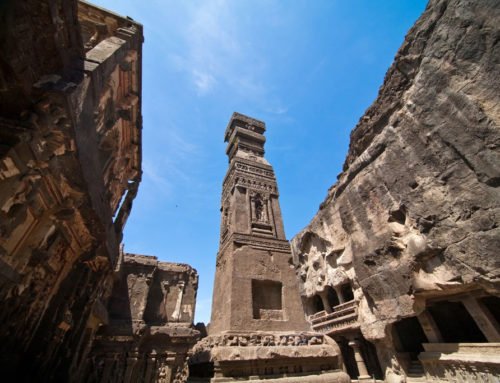
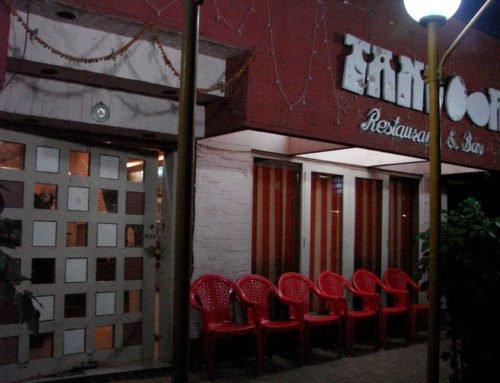
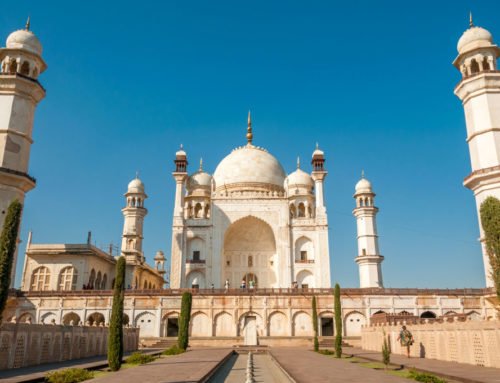
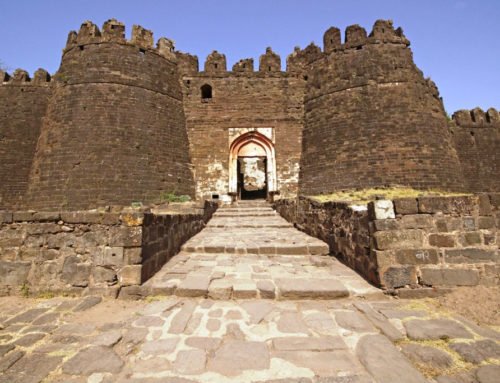
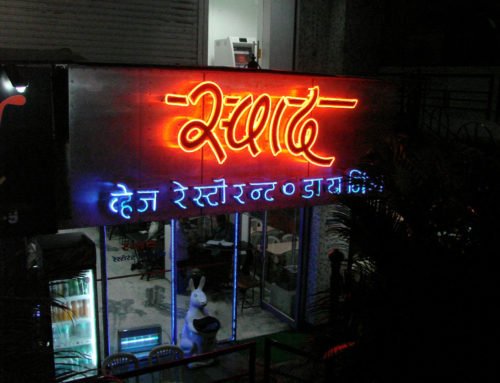
I enjoyed the Palequin ride, rather than walking and see this as something that should be offered at more attractions around the world.
Palanquin rides can be fun and make things more accessible for visitors.